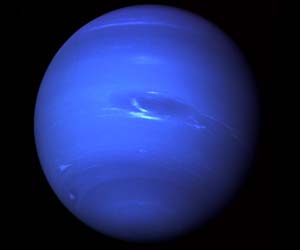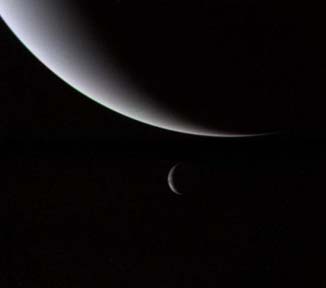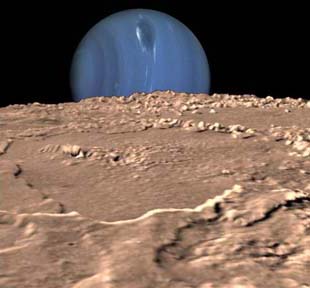|
Our Solar System - Planet Neptune
|
Planet Neptune
 Voyager 2 took this image of Neptune in 1989, it is the only spacecraft to have visted the planet Neptune
Voyager 2 took this image of Neptune in 1989, it is the only spacecraft to have visted the planet Neptune
Triton
 Neptune's largest moon Triton
Neptune's largest moon Triton
Quick Facts
- Neptune is the furthest planet from the sun and the fourth largest.
- It has a diameter of 30,775 miles (49,528 km) which is four times larger than Earth.
- The planet is 30 times further away from the sun than Earth is.
- The dwarf planet Pluto moves inside Neptune's orbit every 248 years, for periods of 20 years.
- Neptune and Uranus are categorised as "ice giants" due to their high levels of water, ammonia and methane.
- The planet gets its blue colour from clouds of frozen methane in its atmosphere.
- Winds in the planet's atmosphere can reach 1300 miles (2,100 km) per hour, the fastest of any planet in the solar system.
- The dark spot in the planet's atmosphere was a violent storm similar to the red spot found on Jupiter, it has disappeared since the Voyager 2 visit.
- The planet was located through mathematical predictions rather than observation.
Orbit, Atmosphere & Temperature
 Close up of Neptune's dark spot
Close up of Neptune's dark spot
Orbit
The planet orbits around the sun every 165 years at an average distance of 2.8 billion miles (4.5 billion km). It spins on its own axis every 16 hours compared to 24 hours on Earth.
Atmosphere
The atmosphere of Neptune is very similar in composition to that of its far neighbour Uranus. Its made up of around 80% hydrogen, 18.5% helium, and 1.5% methane.
Temperature
Due to its far distance from the sun the planet has an extremely cold outer atmosphere with temperatures averaging around -220C (-364F). Temperatures at its centre rise to around 5000C (9000F).
| Moons |
| Discovery & Origin of Name |
Neptune has 11 known satellites, the largest being Triton (picture above) which has a diameter
of around 1,681 miles (2,705 km). It is the only major moon in the solar system
which has a retrograde orbit, meaning it orbits in the opposite direction of
Neptune's rotation. It is thought that Triton was possibly a comet or dwarf
planet that was captured by Neptune's gravity. Unbelievably Triton is
geoligically active, volcanos spew crystals of nitrogen ice 6 miles (10 km)
above its surface. The frozen surface of Triton posseses the coldest known
temperatures in the solar system, -235C (-390F).
Neptune was discovered in 1843 by the young British astronomer John C. Adams.
Scientists had previously known that an unknown planet was interferring with the
orbit of Uranus, Adams made some unbelievable mathematical predictions to
accurately locate the planet. Unfortunately his submitted work was ignored and
it wasn't until three years later when the French astronomer J.J. Leverrier made
the same predictions which led to the planet being found by an observatory in
Berlin. Adams and Leverrier are both credited with its discovery.
Leverrier suggested the name Neptune after the Roman god of the sea.
Leverrier suggested the name Neptune after the Roman god of the sea.
| Future and Past Missions |
Voyager 2
 Launch: August 1977
Launch: August 1977Arrival: June 1989
Agency: NASA
NASA took more risks with Voyager 2 as it was the last planet it would
visit. They flew it much closer to Neptune than any other planet, a mere
3,105 miles (5,000 km). The spacecraft returned impressive images of the
planet and its moons discovering interesting cloud movements and some of the
fastest winds in the solar system. There are no plans to send further
missions.
|
Vital Statistics
Comparison with Earth
|
Diameter: 30,775 miles (49,528 km)
Average Distance from Sun: 2.8 billion miles (4.5 billion km)
Orbital Period: 165 years
Rotation Period: 16.11 hours
Maximium Temperatures: 5000C (9000F) (Core)
Minumum Temperatures: -220C (-364F) (Cloud Tops)
Gravity: 10.71 m/s2 (1.1 x Earth's Gravity)
Density: 1.76 g/cm3 (31.7% Earth's Density)
Mass: 1.0244 x 1026 kg (17 x Earth's Mass)
Volume: 6.2526 x 1013 km3 (58 x Earth's Volume)
Atmosphere: 80% hydrogen, 18.5% helium, and 1.5% methane.
Average Distance from Sun: 2.8 billion miles (4.5 billion km)
Orbital Period: 165 years
Rotation Period: 16.11 hours
Maximium Temperatures: 5000C (9000F) (Core)
Minumum Temperatures: -220C (-364F) (Cloud Tops)
Gravity: 10.71 m/s2 (1.1 x Earth's Gravity)
Density: 1.76 g/cm3 (31.7% Earth's Density)
Mass: 1.0244 x 1026 kg (17 x Earth's Mass)
Volume: 6.2526 x 1013 km3 (58 x Earth's Volume)
Atmosphere: 80% hydrogen, 18.5% helium, and 1.5% methane.
Diameter: 7,926 miles (12,756 km)
Average Distance from Sun: 93 million miles (150 million km)
Orbital Period: 365.24 days
Rotation Period: 23.934 hours
Maximium Surface Temperatures: 58C (136F)
Minumum Surface Temperatures: -88C (-126F)
Gravity: 9.766 m/s2
Density: 5.515 g/cm3
Mass: 5.9737 x 1024 kg
Volume: 1.0832 x 1012 km3
Atmosphere: 78.08% nitrogen, 20.95% oxygen, 0.93% argon, 0.038% carbon dioxide.
Average Distance from Sun: 93 million miles (150 million km)
Orbital Period: 365.24 days
Rotation Period: 23.934 hours
Maximium Surface Temperatures: 58C (136F)
Minumum Surface Temperatures: -88C (-126F)
Gravity: 9.766 m/s2
Density: 5.515 g/cm3
Mass: 5.9737 x 1024 kg
Volume: 1.0832 x 1012 km3
Atmosphere: 78.08% nitrogen, 20.95% oxygen, 0.93% argon, 0.038% carbon dioxide.
| Images |
Neptune's clouds close up


Neptune & Triton crescent


Neptune on Triton's horizon


| Sponsored Links |
